Moonstone is a favorite and very popular crystal. It’s one that many of us are attracted to for its trademark blue flash. Everybody loves that inner sparkle, right? Today, we’re going to talk all about moonstone’s healing properties, correspondences, and meanings.
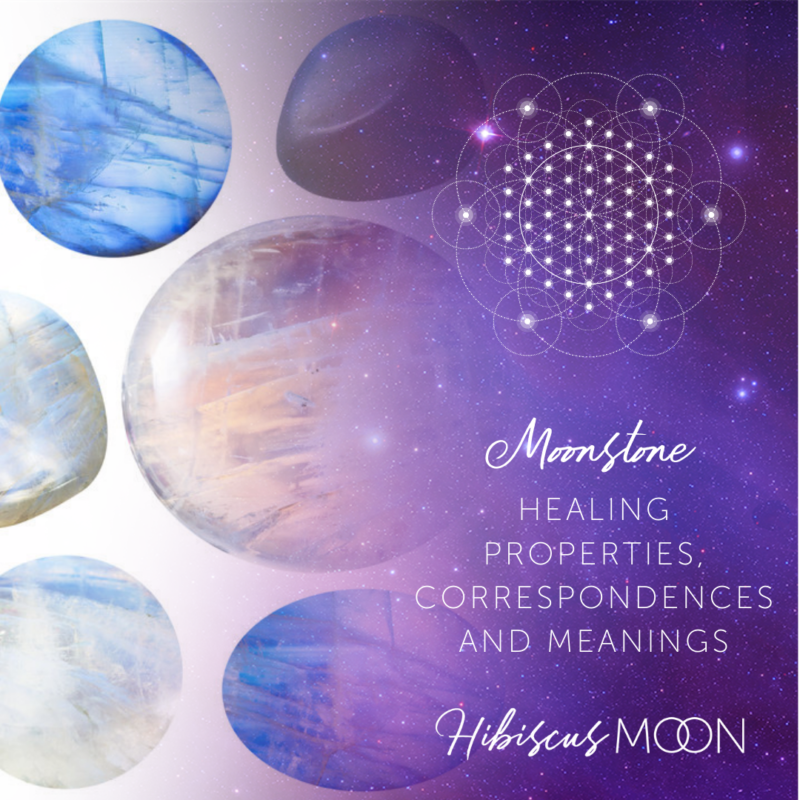
Although Rainbow Moonstone is so gorgeous with that flash, it’s certainly not the only type of moonstone. And, it’s technically not Moonstone as it’s commonly referred to it in the trade. We’ll get to that in a bit here.
While it might be the first one that comes to mind because we are most familiar with seeing the rainbow variation in jewelry, there are many different kinds of Moonstone and it can get a little confusing…
But no worries because as always, I’ve got your back!! We will geek out on the geology below.
So, first, let’s talk about Moonstone’s metaphysical properties.
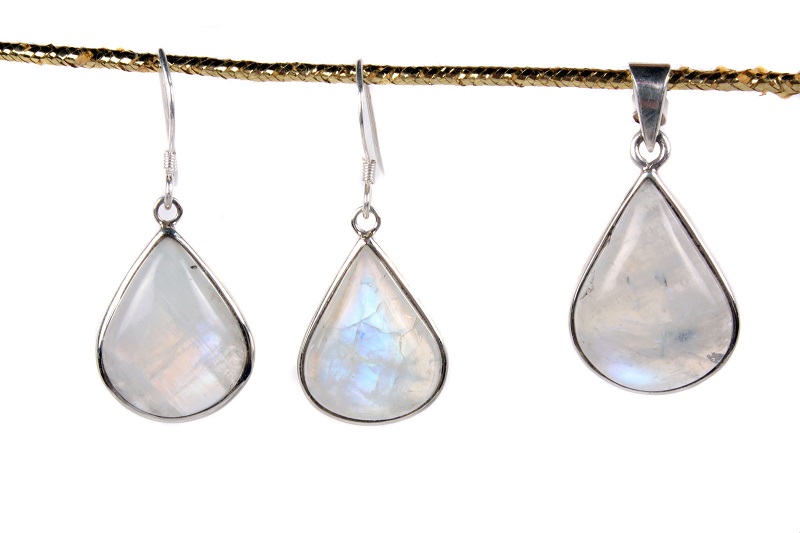
Moonstone Properties + Correspondences
Moonstone is all about:
- Lunar Energy
- Water Connection
- Goddess Energy
- Divine Feminine Energy
- Intuition
It’s ideal for allowing you to tap into your intuition more efficiently.
Moonstone, as the name implies, helps you tap into lunar energy and feminine qualities as the crystal is associated with the Moon, which also rules emotions. Many women find working with moonstone along with our lunar cycles quite effective. However, others may find that they get too emotional if they work with this stone around the Full Moon. You’ll have to try it for yourself and see how it works for you 😉
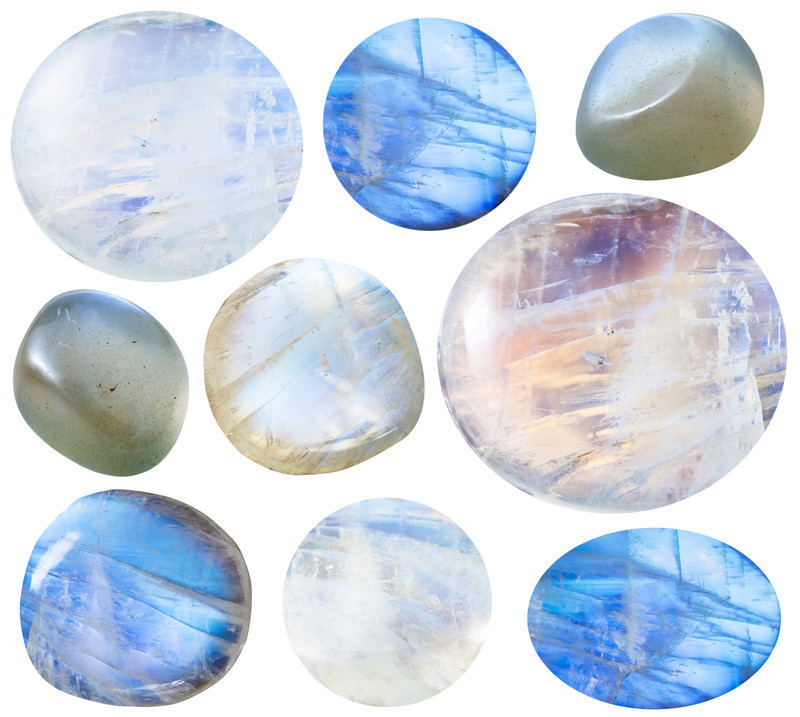
Moonstone Geology
Moonstone is a feldspar mineral specifically made up of orthoclase and albite. Other crystals in the feldspar group include:
- Labradorite
- Sunstone
- Amazonite
Now before I go any further, let us straighten out this Rainbow “Moonstone” confusion:
Here is where it gets a little confusing. Although Moonstone is commonly known as “Rainbow Moonstone” (even in geology classrooms and in the trade), it’s not REALLY Moonstone (orthoclase) at all. Instead, it’s actually a fellow feldspar mineral; a type of Labradorite. If you’ve ever seen that blue flash on Labradorite you can probably see how they’re “close cousins”. Since the name “Rainbow Moonstone” is widely accepted and considered by the professional trade as “Moonstone”, I’m comfy with including it here as a Moonstone. Just wanted you to be aware of that little tidbit.
The one thing that unites all Moonstones is their adularescence. Adularescence is caused by the reflection of light between the layers of minerals. This pearly metallic iridescence is what tends to be most important in the mineral trade. In the trade, it is not as important what the mineral is made of — but rather that it has that distinctive + captivating magical flash of light that seems to move across the crystal’s surface.
Moonstone has a Mohs Hardness of 6 to 6.5, which is a bit softer than quartz but still relatively hard. This hardness score makes it ideal for jewelry.
This mineral comes from Sri Lanka, Myanmar, India, Brazil, Madagascar, Australia, and also the U.S. In some deposits, Moonstone commonly grows alongside Black Tourmaline (and less commonly alongside Smokey Quartz). Hence, when you sometimes see black inclusions (in this cut and polished piece pictured below, for example) that’s Black Tourmaline and the translucent brown is Smokey Quartz. You’ll often see this show up in spheres or palm stones, but the higher-quality gemstones used in jewelry usually don’t have these inclusions.
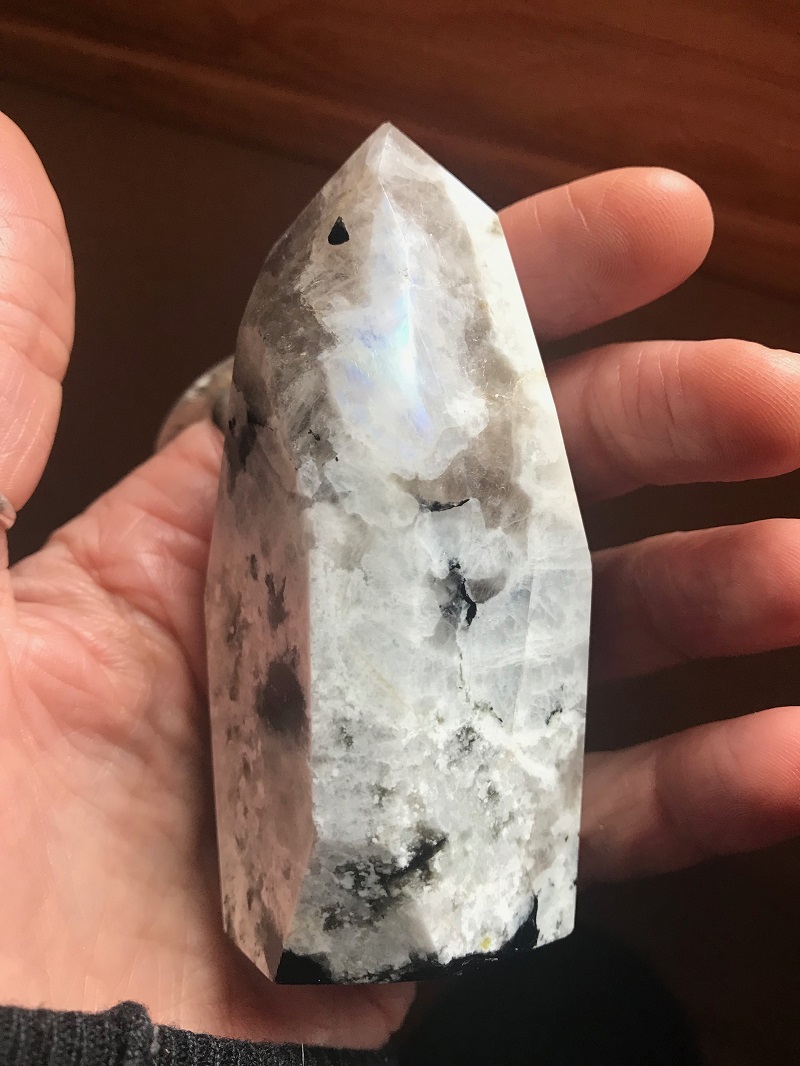
This amazing cut and polished specimen belongs to Team HM’s Content Manager, Lisa. See that telltale blue flash at the top?
Types of Moonstone
Besides the rainbow variety (being the most popular) other varieties include black, peach, white, gray, brown, and colorless. These all have slightly different energies, but as a general rule, they all maintain feminine lunar qualities.
Here’s a brief list of the different types of Moonstone and their primary metaphysical properties:
- Rainbow – Divine Feminine Energy and Intuition
- Peach – Nurturing and Mothering
- Brown, Gray, White – Lunar energies and emotions; gray moonstone is often referred to as “Black Moonstone”
- Colorless – Usually has a white flash; invites awakening and connection to Source Energy and your Higher Self
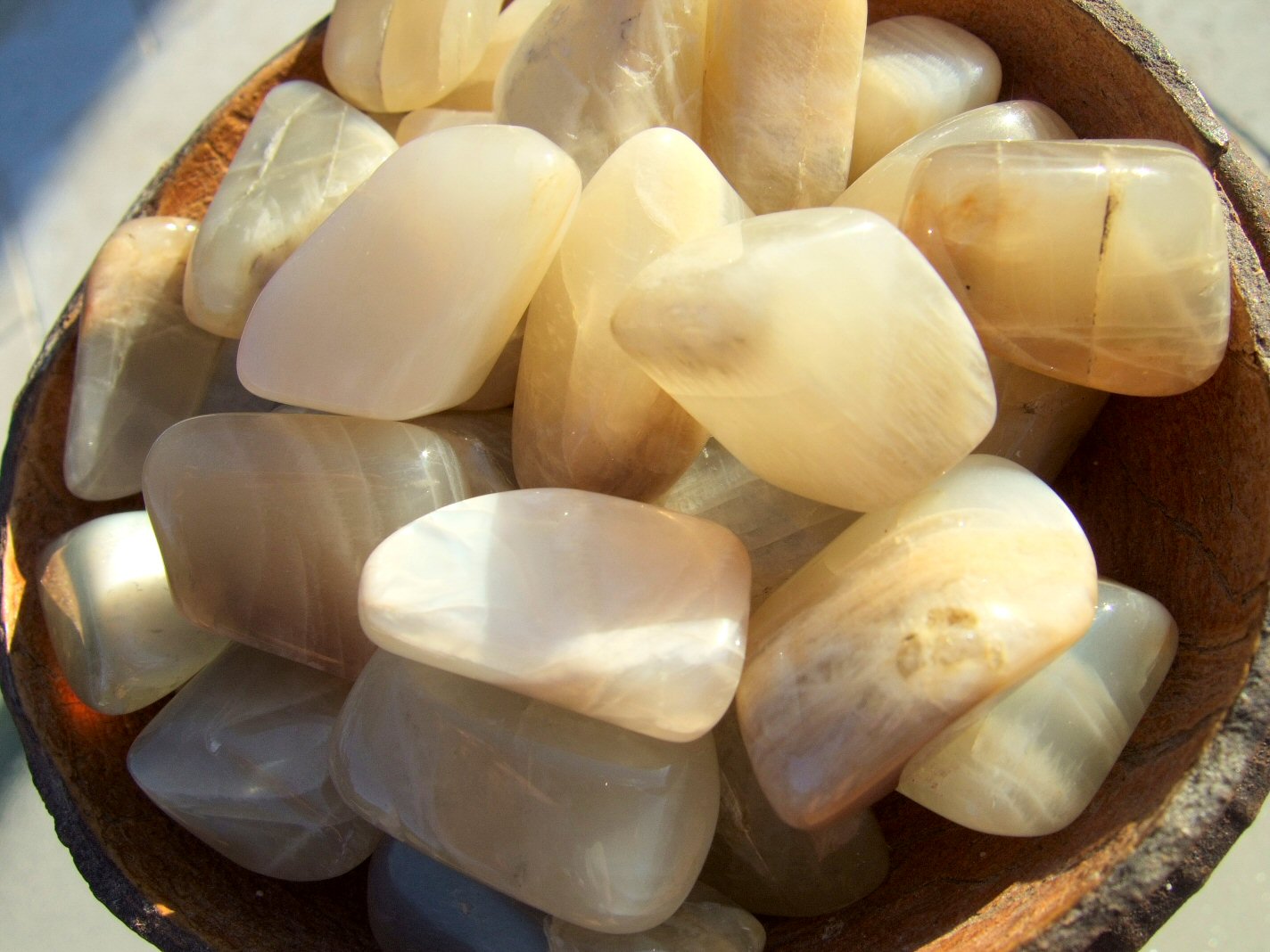
Sometimes, Labradorite is referred to as “Black Labradorite” but this is not correct. Technically, a very dark or blackish stone with the grey and the telltale blue flash is actually Labradorite and not “Moonstone” — and it’s not orthoclase either as already mentioned above.
Chakras
The white and rainbow varieties are often associated with the Third Eye and Crown chakras and have the vibrational frequencies of white and rainbow prism energy associated with the upper chakras.
Moonstone is also used to balance the Sacral Chakra – and in this way, the peach variety works amazingly well!
Colorless Moonstone is ideal for working with the Crown chakra and the higher transpersonal chakras.
Balance with Moonstone
Now, when it comes to certain annual celestial energies such as solstices + equinoxes, I get totally immersed. As the seasons change and the wheel of the year turns, I like to mark special days like the Spring and Autumn Equinox, Summer Solstice, and Winter Solstice.
My go-to pair for working with balancing equinox energies is Moonstone and Sunstone.
This combo is great for bringing in balance and harmony. I have a sphere of each that feels beautifully balanced and I hold one in each hand during meditation. Alternatively, I’ll use these stones on my altar within my sacred space or in a crystal grid to honor these energies.
Why these stones?
Sunstone is all about solar, enlightened male energy…
right?
And we’ve looked at how this crystal is just the opposite: lunar, enlightened female, intuitive energy.
With these two energies working together, it is only natural to find the balance of Yin and Yang, Solar and Lunar, Sun and Moon. The vibrational frequencies of these stones are perfect for reminding us to stay balanced in all aspects of our lives.
I hope you’ve enjoyed this in-depth look at Moonstone!
Do you have any Moonstone in your crystal collection? What’s your favorite way to work with this feminine stone? Please share in the comments below.
Crystal Blessings,


Hi,
Love your information. I love my Crystals. They make me feel so grounded and are beautiful also. The energy in my home and office space is so much cleaner with them. I could sit in the middle of my room surrounded by all of my stones and just vibrate with them. I feel naked if I leave the house and forget to put a necklace with some crystal that I feel connected to that day. I come home feeling overwhelmed. I try not to miss a day not wearing one or more crystals. I love the moonstone. I love the feel and the color of the different types. I love the energy and clarity it brings me.
what is your opinion on Garneirite or as I have also heard it referred to as Green Moonstone?
Found out the hard way. Do NOT wear oonstone and hematite bracelets together. It messes up your energy flow
sorry, my keys Moonstone
Hello, thank you so much for all the beautiful information. I have a green stone I was told is moon stone. Were they Incorrect?
Great article. I never thought of using Sunstone and Moonstone together, I’ve got several nice pieces of each. I’ll have to make a small grid and let the energy flow.
Thanks Hibiscus Moon. Happy Holidays to you and Frank.
I love that I always learn a few new pieces of information from you. I never knew that rainbow moonstone is not actually moonstone. I have two small rainbow moonstone tumbled pieces that I like to hold or carry with me to feel calm and at ease. I also have a raw white piece that I love to leave out during the full moon, and a peach moonstone pyramid that makes me feel so much joy. I realize that I also have a bracelet that has a moonstone in the middle surrounded by amethyst. I have not yet tried working with moonstone along with my cycle, but I may want to give it a try. I also want to try working with a piece along with my sunstone. Thank you again for all the tasty information!
I love moonstone. Am planning on meditating this winter equinox with both moonstone and sunstone to see if will help me balance. Thank you for such an informative article!!
I Love moonstone for dream work.
I love your “metaphysical” united with natural science approach to crystal work. Haven’t been much into moonstone for myself, but have made bracelets with moonstone for daughters and granddaughters because they asked or it was an appropriate stone in the combination of stones for them. However, this article has peaked my interest as it comes shortly after the appearance of a personal interest in moonstone, especially peach and gray moonstone. Have a couple of small “rainbow” palm stones and a “massage” wand in my collection, but can say I’ve used much so far. Winter Blessings!
Moonstone give me the energy of a young female picking flowers for a basket. Fresh morning light. Butterflies and all. Maiden energy.
Moonstone is my absolute go to. I always have a piece on me at all times, whether ring, bracelet or pendant. I am a Libra and love to have balance in my life and this is the one I incorporate with anything and everything. As long as I can remember, I have been drawn to
It. I never thought of using it with sunstone. Will definitely try wearing my sunstone and moonstone rings and feel them. Thank you so much for all the information! Crystal blessings and namaste…..
Hi there Hibiscus! First time I have commented on your blog but I have your crystal grids book on Audible and love it! I also follow your emails and social media accounts – thank you for all the great content! I have a medium-strength draw to moonstone. I have a palm stone i typically include in my full moon grid that i redo every month but that is about it with moonstone. But labradorite! That is one of my favorites! It was really interesting learning how they are related and it makes me want to spend more time with moonstone to get to know it better 🙂 I know you are off right now taking a break from socials and online but I hope you have a wonderful holiday! Thanks for all you do!
Definitely will be wearing moonstone earrings this Equinox. Thank you as ever for your invaluable information and insights. Merry Christmas one and all ????
I always wore moonstone earrings and a moonstone pendant when traveling extensively with my husband years ago (he drives like a madman..LOL) I found very soothing. When I am upset, I still go to moonstone to calm me and remind me that Grandmother Moon is always watching.
I’ve always been attracted to all kinds of moonstone…tumbled, raw, big, small, etc. This is such a wonderful explanation that taught me more about this beautiful stone so I can def dive deeper in my practice! I totally geeked out on everything! Love your blogs & appreciate the newsletters! ????????✨
Thank you for the information. Love crystals and learning about them.
I never thought of using sunstone and moonstone as a balancing duo. It makes great sense tho. I always felt like sunstone was too strong for me, so adding moonstone will make that a usable crystal for me . I will try it on this upcoming total solar eclipse on the New Moon, December 14, 2020. Happy holidays to u and urs and thank you ????????